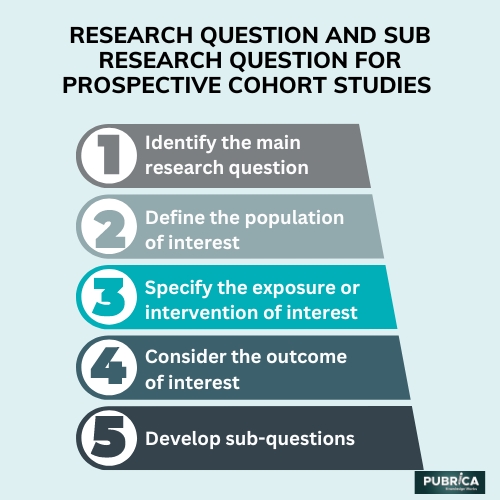
Is there a difference between the theoretical framework and conceptual framework of the study?
April 21, 2023
What is a Good Research Question for Prospective Studies?
April 28, 2023Introduction
Framing a research question for prospective cohort studies requires careful consideration of the specific research topic and population of interest. Here are some steps to follow to frame a research question and sub-questions for prospective cohort studies:
- Identify the main research question: The main research question should be a focused, hypothesis-driven question that clearly defines the research objective. This question should be broad enough to allow for a comprehensive investigation of the topic but specific enough to guide the research process.
- Define the population of interest: The research question should clearly define the population of interest. This may include demographic characteristics such as age, gender, ethnicity, and other relevant factors such as health status or lifestyle habits.
- Specify the exposure or intervention of interest: The exposure or intervention of interest should be specified in the research question. This may include factors such as physical activity, diet, medication use, or environmental exposures.
- Consider the outcome of interest: The research question should clearly define the outcome of interest. This may include specific health outcomes such as disease incidence, mortality rates, or quality of life measures.
- Develop sub-questions: Sub-questions can be used to provide more detail and clarity to the main research question. These questions should be specific, measurable, and relevant to the main research question. They should also be designed to guide the study design and analysis.

Example research question: Does regular physical activity reduce the risk of cardiovascular disease among middle-aged adults over a 10-year period, compared to sedentary ones?
Sub-questions:
- What is the incidence rate of cardiovascular disease among the study population over the 10 years?
- What is the level of physical activity among the study population, and how does it vary over time?
- What are the demographic and lifestyle characteristics of the study population, and how do they influence the risk of cardiovascular disease?
- How does the risk of cardiovascular disease vary according to different levels of physical activity after controlling for other demographic and lifestyle factors?
- What is the dose-response relationship between physical activity and the risk of cardiovascular disease among middle-aged adults over a 10-year period?
Some possible research objectives based on the research question:
- To investigate the incidence rate of cardiovascular disease among middle-aged adults over a 10-year period.
- Assess the level of physical activity among the study population and how it varies over time.
- To examine the demographic and lifestyle characteristics of the study population and how they influence the risk of cardiovascular disease.
- After controlling for other demographic and lifestyle factors, determine the relationship between physical activity and cardiovascular disease risk among middle-aged adults.
- To explore the dose-response relationship between physical activity and the risk of cardiovascular disease among middle-aged adults over a 10-year period.
These research objectives provide more specific details about the focus and scope of the study. Each objective can be used to guide the research process, including study design, data collection, and analysis.
Some possible hypotheses based on the Medical Case Study Report Writing research question:
- Null hypothesis: There is no significant difference in the incidence rate of cardiovascular disease between physically active middle-aged adults and those who are sedentary over a 10-year period.
- Alternative hypothesis: Physically active Middle-aged adults have a lower incidence rate of cardiovascular disease compared to those who are sedentary over a 10-year period.
- Null hypothesis: There is no significant difference in the level of physical activity between middle-aged adults who develop cardiovascular disease and those who do not over 10 years.
- Alternative hypothesis: Middle-aged adults who develop cardiovascular disease have a lower level of physical activity compared to those who do not over a 10-year period.
- Null hypothesis: There is no significant relationship between demographic and lifestyle characteristics and the risk of cardiovascular disease among middle-aged adults over a 10-year period.
- Alternative hypothesis: Demographic and lifestyle characteristics are associated with the risk of cardiovascular disease among middle-aged adults over a 10-year period.
About Pubrica
The team of researchers and writers at Pubrica creates scientific and medical study papers that can serve as invaluable resources for practitioners and authors. Using the reader to inform them of the gaps in the chosen study area, Pubrica medical writers assist you in writing and editing the introduction. Our specialists are conscious of the order in which the general topic, the issue, and the background are followed by the narrow subject where the hypothesis is stated.
References
Morton, Sally C., et al. “Quantitative synthesis—an update.” Methods Guide for Effectiveness and Comparative Effectiveness Reviews [Internet] (2018).
